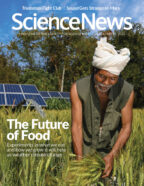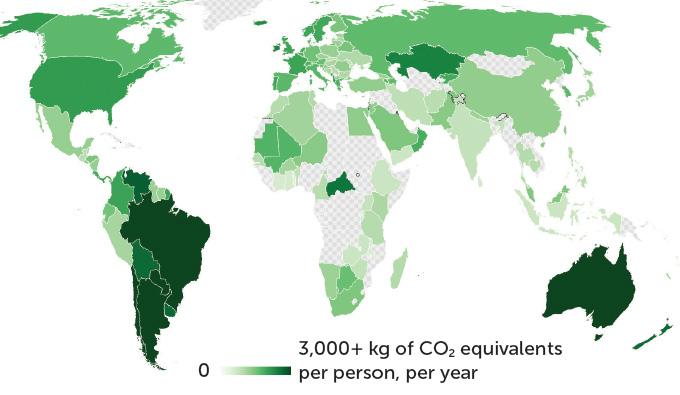This post was originally published on this site

Meaty data
Food production contributes substantially to global greenhouse gas emissions. Altering your diet can reduce those emissions, Betsy Ladyzhets reported in “Food choices” (SN: 5/7/22 & 5/21/22, p. 22).
The story displayed a map showing the impact of an average person’s diet, by country, on greenhouse gas emissions (see “Putting emissions on the map,” below). Reader Steve Woodbury wondered whether the map depicts emissions attributable to countries’ consumption or exportation of food products.
On this map, the greenhouse gas emissions are counted only in the country where the food use is happening, Ladyzhets says. The scientists who worked on this analysis chose to focus on modeling consumption habits because “the majority of food produced in most countries is consumed domestically,” she says.
All about the fight
A hole in the skull of a Triceratops dubbed “Big John” may have been a battle scar sustained during a fight with a peer, Anna Gibbs reported in “Triceratops hole may be a combat injury” (SN: 5/7/22 & 5/21/22, p. 20).
Reader Dale S. Smith asked how scientists know that Big John was male, and whether the injury could have resulted from mating with a female.
We know that Big John is most likely male because of the morphology and measurements of the skeleton, particularly the skull and pelvis, says Ruggero D’Anastasio, a paleopathologist at the “G. D’Annunzio” University of Chieti-Pescara in Italy.
It’s unlikely that the injury happened during mating, D’Anastasio says. The location and shape of the wound indicates that it was inflicted from behind, which is probably not where a female Triceratops would be positioned during mating, he says. The shape of the hole also suggests that a large horn penetrated perpendicular to the skull’s bony frill. If the injury was sustained during mating, the lesion would likely have a different shape, caused by a big horn that pierced the skull’s fan at an acute rather than perpendicular angle, he says.
But it’s possible that mating rivalry had a part in the brawl. “In many animal species, males struggle with each other to acquire the right to mate with females,” D’Anastasio says. “It is all about fighting.”
Mass mismatch
A new measurement suggests the W boson may have a higher mass than expected, revealing a potential flaw in the standard model of particle physics, Emily Conover reported in “Subatomic particle may be extra hefty” (SN: 5/7/22 & 5/21/22, p. 12).
The W boson’s newly measured mass is 80,433.5 million electron volts, Conover reported. That exceeds the predicted mass of 80,357 MeV by roughly 0.1 percent. Reader Jerry Boehm asked if such a tiny discrepancy is significant enough for scientists to discuss the prospect of new particles.
In short, yes, Conover says. “Even though that sounds like a very small mismatch, physicists have determined the measured and predicted W boson masses so precisely that the discrepancy is much bigger than expected,” she says. “The W boson mass was measured to a precision of 0.01 percent, similar to that of the predicted mass. So we’d expect those values to be much closer together, unless we’re missing something. That ‘something’ could be an exciting find, like new particles, or it could mean that there’s something else that’s not accounted for properly in either the measurement or the prediction.”

